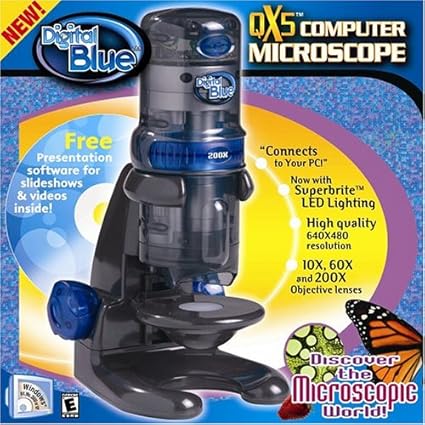
Digital Blue Usb Microscope Drivers
Digital Blue QX7 Microscope- New Model Review - The Digital Blue QX7 microscope is the next generation in the QX series with improved features from older popular versions, the QX3 and the QX5 and is still very affordable. MiXscope QXScope supports the Intel Play QX3, Digital Blue QX3, Digital Blue QX5, and Smithsonian QX5 USB Computer Microscopes. QXScope enables Mac.
Learn more • • • • • • The Plugable USB2-Micro-200X USB microscope provides up to 50X magnification optically and up to 200x and can be used on computers running Windows, Mac OS X, or Linux simply by plugging it into a spare USB 2.0 port and it requires no external power. It operates like a standard webcam and can be used with the default webcam software included in your computer’s operating system.
Setup and Drivers Since our microscope uses a standard webcam chipset, it will automatically install default webcam drivers when plugged in to a computer. It can be used with any webcam app, like the camera app built in to Windows 8.1, Photo Booth in OSX, or a third party program like VLC media player. We also have custom Windows and OSX software designed specifically to work with the microscope. 
Q: I can’t get my microscope to zoom past ~30x indicated magnification, how do i get to 200x? A: At the closest distance with the clear shield touching the object, there are two possible magnifications. The first is at around 30x indicated, but if you continue to rotate the focus wheel, the image will get blurry, then sharp again at around 200x indicated!
Q: How do I dim the LED lights? A: The LED lights can be dimmed or turned off by rotating the black LED light control wheel near the rear of the microscope. If you are having problems with glare, try viewing your intended object at an angle. Q: I see a “device not detected” message in MicroCapture when it’s clearly connected.
Testi kejsi s otvetami po marketingu. A: You may have to disconnect and reconnect the microscope when restarting MicroCapture, and it can take up to 30 seconds for MicroCapture to detect the microscope. It’s also possible that the microscope isn’t running under it’s specialized driver that MicroCapture requires in order to see the microscope.
If none of this helps, please contact us at support@plugable.com and we can help troubleshoot the issue.
Fun with a QX5 digital microscope. A personal review. By David Walker, UK Notes on its use both as a toy, and with modification, its potential as a cheap imaging route for the microscopy enthusiast.
Summary: As a toy: A great way of introducing the youngster to the world at the microscopic scale and digital imaging. The higher resolution sensor can give smoother results than the QX3. The LED's provide a cooler better colour balanced illumination. Works well for top lit subjects at all mags or bottom lit at 10x and 60x.

The time lapse is a particularly exciting feature. The bottom light isn't strong enough at 200x for best results but a modification can significantly improve them. For the youngster expressing a particular interest in prepared slides and higher mags, a student compound optical microscope which sell in a similar price range would offer superior results. The 'sample measurement tool' mentioned on the maker's website is apparently a hardware feature not part of earlier units, including the author's example.